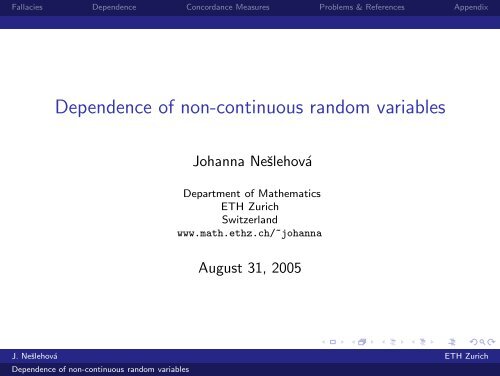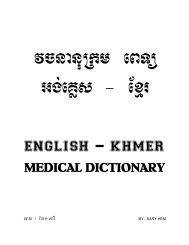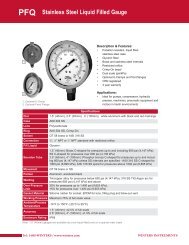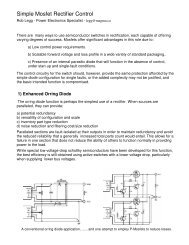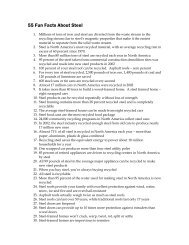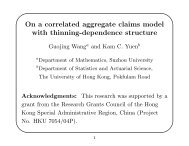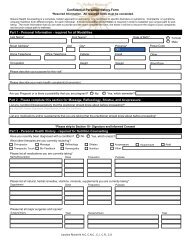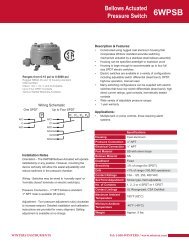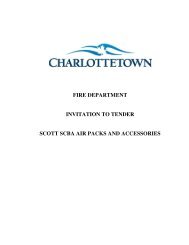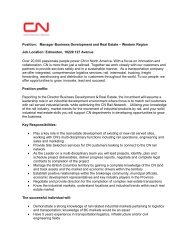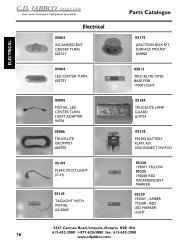Dependence of non-continuous random variables
Dependence of non-continuous random variables
Dependence of non-continuous random variables
You also want an ePaper? Increase the reach of your titles
YUMPU automatically turns print PDFs into web optimized ePapers that Google loves.
Fallacies <strong>Dependence</strong> Concordance Measures Problems & References Appendix<strong>Dependence</strong> <strong>of</strong> <strong>non</strong>-<strong>continuous</strong> <strong>random</strong> <strong>variables</strong>Johanna NešlehováDepartment <strong>of</strong> MathematicsETH ZurichSwitzerlandwww.math.ethz.ch/~johannaAugust 31, 2005J. Nešlehová ETH Zurich<strong>Dependence</strong> <strong>of</strong> <strong>non</strong>-<strong>continuous</strong> <strong>random</strong> <strong>variables</strong>
Fallacies <strong>Dependence</strong> Concordance Measures Problems & References AppendixMotivationConsider• Two possibly dependent loss types andN i (T) = number <strong>of</strong> losses <strong>of</strong> type i within the year T• <strong>Dependence</strong> structures <strong>of</strong> the pair <strong>of</strong> <strong>non</strong> <strong>continuous</strong> <strong>random</strong><strong>variables</strong>(N 1 (T),N 2 (T))Other examples• Counting <strong>random</strong> <strong>variables</strong> like claim/loss frequencies ornumber <strong>of</strong> defaults in a portfolio• Variables with jumps like losses censored by a certain thresholdJ. Nešlehová ETH Zurich<strong>Dependence</strong> <strong>of</strong> <strong>non</strong>-<strong>continuous</strong> <strong>random</strong> <strong>variables</strong>
Fallacies <strong>Dependence</strong> Concordance Measures Problems & References AppendixDistributions with <strong>continuous</strong> marginals• Notation: (X,Y ) ∼ F with marginals F 1 and F 2F 1 and F 2 <strong>continuous</strong>1. There exists a unique copula C such thatF(x,y) = C(F 1 (x),F 2 (y)) (Sklar’s theorem)2. Modeling <strong>of</strong> the marginals and the copula can be doneseparately3. C captures dependence properties which are invariat under a.s.strictly increasing transformations <strong>of</strong> the marginals4. Scale and translation invariant measures <strong>of</strong> dependence arefunctions <strong>of</strong> C alone➠ C is the (scale and location invariant) dependence structureJ. Nešlehová ETH Zurich<strong>Dependence</strong> <strong>of</strong> <strong>non</strong>-<strong>continuous</strong> <strong>random</strong> <strong>variables</strong>
Fallacies <strong>Dependence</strong> Concordance Measures Problems & References AppendixPathological Example2/3q1/31/3 p 2/3J. Nešlehová ETH Zurich<strong>Dependence</strong> <strong>of</strong> <strong>non</strong>-<strong>continuous</strong> <strong>random</strong> <strong>variables</strong>
Fallacies <strong>Dependence</strong> Concordance Measures Problems & References AppendixPathological Example2/3q1/3• (p,q) ∈ [0,1/3] × [0,1/3]:perfect positive dependence• (p,q) = (1/ √ 3,1/ √ 3):independence• (p,q) ∈ [2/3,1] × [2/3,1]:perfect negative dependence1/3 p 2/3J. Nešlehová ETH Zurich<strong>Dependence</strong> <strong>of</strong> <strong>non</strong>-<strong>continuous</strong> <strong>random</strong> <strong>variables</strong>
Fallacies <strong>Dependence</strong> Concordance Measures Problems & References AppendixFurther Pitfalls• The copula is not unique; i.e. several possible copulas exist• The dependence structures <strong>of</strong> F are generally not the same asthe dependence structures <strong>of</strong> the possible copulasF(x,y) ≤ F ∗ (x,y) ∀x,y ∈ R ⇏ C(u,v) ≤ C ∗ (u,v) ∀u,v ∈ [0,1]• Possible copulas remain invariant under strictly increasing and<strong>continuous</strong> transformations, but do not necessarily change inthe same way as the unique copula in the “<strong>continuous</strong>” case ifat least one <strong>of</strong> the transformations is decreasing• Weak convergence <strong>of</strong> F n does not imply the point-wiseconvergence <strong>of</strong> the corresponding possible copulas• Any measure <strong>of</strong> association which depends only on the copula<strong>of</strong> F is a constantJ. Nešlehová ETH Zurich<strong>Dependence</strong> <strong>of</strong> <strong>non</strong>-<strong>continuous</strong> <strong>random</strong> <strong>variables</strong>
Fallacies <strong>Dependence</strong> Concordance Measures Problems & References AppendixKendall’s Tau and Spearman’s rho in the”Non-Continuous” Case?”Naive” Idea: work with some <strong>of</strong> the <strong>non</strong> unique fitting copulaBut: fitting copulas can differ considerably.• For independent Bernoulli <strong>random</strong> <strong>variables</strong> X and Y◮ τ(X, Y ) ∈ [−3/4, 3/4]◮ ρ(X, Y ) ∈ [−13/16, 13/16]• for comonotonic Bernoulli <strong>random</strong> <strong>variables</strong> X and Y◮ τ(X, Y ) ∈ [0, 1]◮ ρ(X, Y ) ∈ [1/2, 1]Because: Difference between the probability <strong>of</strong> concordance anddiscordance ≠ 4 ∫ C(u,v)dC ∗ (u,v) − 1J. Nešlehová ETH Zurich<strong>Dependence</strong> <strong>of</strong> <strong>non</strong>-<strong>continuous</strong> <strong>random</strong> <strong>variables</strong>
Fallacies <strong>Dependence</strong> Concordance Measures Problems & References AppendixSome Starting Points• Investigation <strong>of</strong> the family <strong>of</strong> possible copulas correspondingto a fixed bivariate distribution◮ In particular search for a suitable extension strategy whichwould produce a copula capturing the dependence structures<strong>of</strong> the joint distribution function• Investigation <strong>of</strong> possible bivariate distributions obtained froma fixed copula and marginals which follow some specifieddistribution (up to parameters), such as Poisson, binomial orBernoulliJ. Nešlehová ETH Zurich<strong>Dependence</strong> <strong>of</strong> <strong>non</strong>-<strong>continuous</strong> <strong>random</strong> <strong>variables</strong>
Fallacies <strong>Dependence</strong> Concordance Measures Problems & References AppendixThe ”Standard” Extension StrategyC(0.4, 0.4) = 0C(0.4, 0.4) = 0.16C(0.4, 0.4) = 0.31110.80.80.80.60.60.6yyy0.40.40.40.20.20.2000.20.40.60.81000.20.40.60.81000.20.40.60.81xxxThe Standard Extension C S• The standard extension copula <strong>of</strong> Schweizer and Sklar• C S corresponds to the linear interpolation <strong>of</strong> the uniquesubcopula as well as the unique copula <strong>of</strong> the smoothed jdfJ. Nešlehová ETH Zurich<strong>Dependence</strong> <strong>of</strong> <strong>non</strong>-<strong>continuous</strong> <strong>random</strong> <strong>variables</strong>
Fallacies <strong>Dependence</strong> Concordance Measures Problems & References AppendixSome Selected Properties <strong>of</strong> C SPros• X and Y are independent if and only if C S is theindependence copula• (X ∗ ,Y ∗ ) more concordant than (X,Y ) if and only ifC S (u,v) ≤ CS ∗ (u,v) for all u,v ∈ [0,1]• C S reacts on monotone transformations <strong>of</strong> the marginals asthe unique copula in the “<strong>continuous</strong>” caseCons• If X and Y are perfect monotonic dependent, C S does notcoincide with the Fréchet-Hoeffding bounds• Weak convergence does not imply the point-wise convergence<strong>of</strong> the C S ’sJ. Nešlehová ETH Zurich<strong>Dependence</strong> <strong>of</strong> <strong>non</strong>-<strong>continuous</strong> <strong>random</strong> <strong>variables</strong>
Fallacies <strong>Dependence</strong> Concordance Measures Problems & References AppendixTowards Kendall’s Tau and Spearman’s RhoDifference between the probabilities <strong>of</strong> concordance anddiscordance equals 4 ∫ C S (u,v)dC S ∗ (u,v) − 1Consider• Kendall’s tau: ˜τ(C S ) = 4• Spearman’s rho: ˜ρ(C S ) = 12However∫ 1 ∫ 100∫ 1 ∫ 1• ˜τ and ˜ρ do not reach the bounds 1 and −10C S (u,v) dC S (u,v) − 10[C S (u,v) − uv] du dv• Exact bounds <strong>of</strong> ˜τ and ˜ρ are complicated and do not have thesame absolute valueJ. Nešlehová ETH Zurich<strong>Dependence</strong> <strong>of</strong> <strong>non</strong>-<strong>continuous</strong> <strong>random</strong> <strong>variables</strong>
Fallacies <strong>Dependence</strong> Concordance Measures Problems & References AppendixExact Bounds for Kendall’s Tau and Spearman’s Rho1.51.5110.50.5000.20.4x0.60.8000.20.4x0.60.8-0.5-0.5-1-1|˜τ(M S )/˜τ(W S )| for Binomialdistributions F 1 = B(n, 0.4) andF 2 = B(n, x) with n =1,4 and 10.|˜ρ(M S )/˜ρ(W S )| for Binomialdistributions F 1 = B(n, 0.4) andF 2 = B(n, x) with n =1,4 and 10.J. Nešlehová ETH Zurich<strong>Dependence</strong> <strong>of</strong> <strong>non</strong>-<strong>continuous</strong> <strong>random</strong> <strong>variables</strong>
Fallacies <strong>Dependence</strong> Concordance Measures Problems & References AppendixLess Sharp Bounds for Kendall’s Tau and Spearman’s Rho1. |˜τ(X,Y )| ≤ √ 1 − E ∆F 1 (X) √ 1 − E∆F 2 (Y ). The boundsare attained if Y = T(X) a.s. where T is a strictly monotoneand <strong>continuous</strong> transformation on the range <strong>of</strong> X.2. |˜ρ(X,Y )| ≤ √ 1 − E ∆F 1 (X) 2√ 1 − E ∆F 2 (Y ) 2 . The boundsare attained if Y = T(X) a.s. where T is a strictly monotoneand <strong>continuous</strong> transformation on the range <strong>of</strong> X.J. Nešlehová ETH Zurich<strong>Dependence</strong> <strong>of</strong> <strong>non</strong>-<strong>continuous</strong> <strong>random</strong> <strong>variables</strong>
Fallacies <strong>Dependence</strong> Concordance Measures Problems & References AppendixKendall’s Tau and Spearman’s Rho for Non-ContinuousRandom Variables1∫ ∫ 14 C S (u,v) dC S (u,v) − 10 0τ(X,Y ) = √[1 − E ∆F1 (X)][1 − E∆F 2 (Y )](∫1∫ 1 (12 CS (u,v) − uv ) )du dv0 0ρ(X,Y ) = √[1 − E ∆F1 (X) 2 ][1 − E∆F 2 (Y ) 2 ]• τ and ρ satisfy (modified) axioms <strong>of</strong> concordance measures• Bounds are attained if X a.s. = T(Y ) for T <strong>continuous</strong> andstrictly monotone• τ and ρ are the sample versions for empirical distributionsJ. Nešlehová ETH Zurich<strong>Dependence</strong> <strong>of</strong> <strong>non</strong>-<strong>continuous</strong> <strong>random</strong> <strong>variables</strong>
Fallacies <strong>Dependence</strong> Concordance Measures Problems & References Appendixτ, ρ and ϱ for Binomial Distributions1110.80.80.80.60.60.60.40.40.40.20.20.200.20.40.60.8 10 0.2 0.40.60.8100.20.40.60.8 1xxxF 1 = B(2, 0.4), F 2 = B(2, x).x0 0.2 0.4 0.6 0.8 1F 1 = B(4, 0.4), F 2 = B(4, x).x0 0.2 0.4 0.6 0.8 1F 1 = B(10, 0.4), F 2 = B(10, x).x0 0.2 0.4 0.6 0.8 1-0.2-0.2-0.2-0.4-0.4-0.4-0.6-0.6-0.6-0.8-0.8-0.8-1-1-1J. Nešlehová F 1 = B(2, 0.4), F 2 = B(2, x). F 1 = B(4, 0.4), F 2 = B(4, x). F 1 = B(10, 0.4), F 2 = B(10, ETHx).Zurich<strong>Dependence</strong> <strong>of</strong> <strong>non</strong>-<strong>continuous</strong> <strong>random</strong> <strong>variables</strong>
Fallacies <strong>Dependence</strong> Concordance Measures Problems & References AppendixSome Problems• Modeling: dependence properties <strong>of</strong> a familyH = {C(F,G) : F ∈ F,G ∈ G}Kendall’s tau0.0 0.1 0.2 0.3 0.4 0.5Kendall’s tau0.0 0.1 0.2 0.3 0.4 0.5Kendall’s tau0.0 0.1 0.2 0.3 0.4 0.50.0 0.2 0.4 0.6 0.8 1.0q0.0 0.2 0.4 0.6 0.8 1.0q0 100 200 300qKendall’s tau for binomial marginals and a Gauss copula (solidline), Frank copula (short-dashed line), Gumbel copula (dottedline), and Fréchet copula (long-dashed line).J. Nešlehová ETH Zurich<strong>Dependence</strong> <strong>of</strong> <strong>non</strong>-<strong>continuous</strong> <strong>random</strong> <strong>variables</strong>
Fallacies <strong>Dependence</strong> Concordance Measures Problems & References AppendixSome Theory Behind: <strong>Dependence</strong> Structure in theNon-Continous CaseIn the <strong>continuous</strong> case: C is the cdf. <strong>of</strong> the transformed vector(F 1 (X),F 2 (Y )).Idea: In the <strong>non</strong>-<strong>continuous</strong> case, use a different transformation <strong>of</strong>the marginals:ψ(x,u) := P[X < x] + uP[X = x] = F(x−) + u∆F(x)Result: for a <strong>random</strong> vector (U,V) with uniform marginals whichis independent <strong>of</strong> (X,Y ), (ψ(X,U),ψ(Y ,V)) has uniformmarginals and the corresponding unique copula is a possible copula<strong>of</strong> (X,Y ).Moreover: different dependence structure <strong>of</strong> (U,V) leads todifferent possible copulas <strong>of</strong> (X,Y).J. Nešlehová ETH Zurich<strong>Dependence</strong> <strong>of</strong> <strong>non</strong>-<strong>continuous</strong> <strong>random</strong> <strong>variables</strong>


